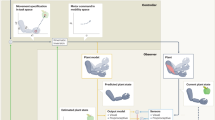Abstract
A new approach is presented to deal with the problem of modelling and simulating the control mechanisms underlying planned-arm-movements. We adopt a synergetic view in which we assume that the movement patterns are not explicitly programmed but rather are emergent properties of a dynamic system constrained by physical laws in space and time. The model automatically translates a high-level command specification into a complete movement trajectory. This is an inverse problem, since the dynamic variables controlling the current state of the system have to be calculated from movement outcomes such as the position of the arm endpoint. The proposed method is based on an optimization strategy: the dynamic system evolves towards a stable equilibrium position according to the minimization of a potential function. This system, which could well be described as a feedback control loop, obeys a set of non-linear differential equations. The gradient descent provides a solution to the problem which proves to be both numerically stable and computationally efficient. Moreover, the addition into the control loop of elements whose structure and parameters have a pertinent biological meaning allows for the synthesis of gestural signals whose global patterns keep the main invariants of human gestures. The model can be exploited to handle more complex gestures involving planning strategies of movement. Finally, the extension of the approach to the learning and control of non-linear biological systems is discussed.
Similar content being viewed by others
Explore related subjects
Discover the latest articles, news and stories from top researchers in related subjects.References
D. Luenberger,Optimization by Vector Space Methods, John Wiley, 1970.
H. Haken,Advanced Synergetics, Springer Verlag, 1983.
D. Bullock and S. Grossberg, “Neural dynamics of planned-arm movements: emergent invariants and speed accuracy properties during trajectory formation,” inNeural Networks and Natural Intelligence, S. Grossberg, MIT Press, 1988.
S. Grossberg and M. Kuperstein,Neural Dynamics of Adaptive Sensory-Motor Control (expanded edition), Pergamon Press, 1989.
J.Ch. Gille, P. Decaulne, and M. Pélegrin,Systèmes asservis non linéaires, Dunod (5e édition), 1988.
P. Viviani and C. Terzuolo, “The organization of movement in handwriting and typing,” inLanguage production II, Butterworth Ed., 1983.
P. Viviani and M. Cenzato, “Segmentation and coupling in complex movements,”Journal of Experimental Psychology: Human Perception and Performance, 11, pp. 828–845.
L.D. Landau and E.M. Lifshitz,Mechanics. A course of theoretical physics, Vol. 1, Pergamon Press, 1976.
S. Gibet, “Gestural control of sound synthesis processes,” I.N.R.I.A. (Institut National de Recherche en Informatique et en Automatique), Annual Report, 1990.
L. Ljung, Söderström,Theory and practice of Recursive Identification, MIT Press, 1983.
D.E. Rumelhart, G.E. Hinton, and R.J. Williams, “Learning internal representations by error propagation,” inParallel distributed processing, Vol. 1, edited by D.E. Rumelhart & J.L. McClelland, MIT Press, Cambridge, MA, pp. 318–363, 1986.
M. Jordan, “Indeterminate motor skill learning problems,” inAttention and Performance XIII, edited by Jeannerod, Hillsdale, NJ: Lawrence Erlbaum.
J. Albus, “A New Approach to Manipulator Control: The Cerebellar Model Articulation Controller,” Transactions of ASME,Journal of Dynamic Systems, Measurement and Control, Vol. 97, pp. 220–227, September 1975.
R. Elsey, “Neural Network mechanisms for generation and learning of motor programs,”IEEE Conf. on Neural Networks, Vol. II, pp. 584–587, 1988.
V. Gullapalli, “A Stochastic Reinforcement Learning Algorithm for Learning Real-Valued Function,”Neural Networks, Vol. 3, pp. 671–692, 1990.
M. Kawato, K. Furukawa, and R. Suzuki, “Hierarchical Neural-Network for Control and Learning of Voluntary Movement,”Biol. Cybern., Vol. 57, pp. 169–185, 1987.
M. Kuperstein, “Adaptive Visual-Motor Coordination in Multijoint Robots Using Parallel Architecture,”Proceedings of the 1987 IEEE International Conference on Robotics and Automation, pp. 1595–1601, Raleigh, March 1987.
W.T. Miller, “Sensor-based Control of Manipulation Robots Using a General Learning Algorithm,”IEEE Journal of Robotics and Automation, Vol. RA-3, pp. 157–165, April 1987.
M. Railbert and J. Craig, “Hybrid position/force control of manipulators,”Journal of Dynamic Systems, Measurement and Control, 102, 126–133, June 1981.
H. Ritter, T. Martinetz, and K. Schulten, “Topology-conserving Maps for Learning Visuomotor Coordination,”Neural Networks, Vol. 2, pp. 159–168, 1989.
B. Horne, M. Jamshidi, and N. Vadiee, “Neural Networks in Robotics: A Survey,”Journal of Intelligent and Robotic Systems, Vol. 3, pp. 51–66, 1990.
Author information
Authors and Affiliations
Rights and permissions
About this article
Cite this article
Gibet, S., Marteau, PF. A self-organized model for the control, planning and learning of nonlinear multi-dimensional systems using a sensory feedback. Appl Intell 4, 337–349 (1994). https://doi.org/10.1007/BF00872473
Issue Date:
DOI: https://doi.org/10.1007/BF00872473




